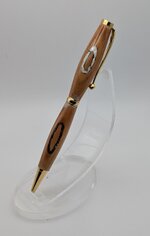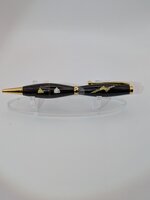TLowe2
Member
Hello all, I recently started using CA for my finishes and am learning what works and what doesn't. One problem I've ran into a few times is when I'm at the assembly stage and I press my blanks together a cloud pocket forms on the end. Does anyone have any tips to prevent this? It has happened 3 times in a row. 
These pens are:
Olivewood with real T-Rex fossil inlay and silver inlay. Ebony with inlayed T-Rex fossil scales of justice weighing gold and silver triangles and a gold lightning bolt with diamond dust.
For what it's worth real T-Rex fossil is ~$15 for a small bag of tiny bits which is enough to do a lot of inlays! The silver and gold I used were both very thing sheets!
I am nowhere near where I want to be before leveling up to more expensive pen kits so I am practicing on slimlines.
These pens are:
Olivewood with real T-Rex fossil inlay and silver inlay. Ebony with inlayed T-Rex fossil scales of justice weighing gold and silver triangles and a gold lightning bolt with diamond dust.
For what it's worth real T-Rex fossil is ~$15 for a small bag of tiny bits which is enough to do a lot of inlays! The silver and gold I used were both very thing sheets!
I am nowhere near where I want to be before leveling up to more expensive pen kits so I am practicing on slimlines.


